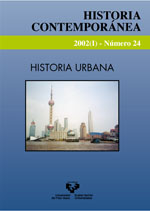Urban history and Working-Class history: reflectins on Working-clas life and urban space, 1900-1950
##plugins.themes.bootstrap3.article.main##
##plugins.themes.bootstrap3.article.sidebar##
Abstract
The article provides some keys to relate City and Working-Class. Urban space, specialy in the great city of the first twentieth Century, was not a pasive element in Working-Class formation. Social segregation, housing, journey to work and neigbourhood community of European cities are examined in a comparative approach. The Second World War was a turning point for working-class life in these issues. Workers were more segregated from the non-manual social classes specially in the new suburban council housing. Journey to work were longer. Primary community networks —kinship, neighbours, friendship— survived, but secondary networks started their decline.
Nor the different Working sectors neither the different cities changed in the same way. Skilled and white collar workers were often the protagonists of the transformations. Unskilled workers preserved the old patterns to a great extent. In the «cities of the South» transformations were not so profound as in the «cities of the North». These cities were the stage of a gradual fragmentation of the different Working-Class strata in urban areas more and more separated. A fragmentation wich also affected the old geographical unity between work and home and the social networks in the neigbourhood. The article finally suggests a relation of these issues with the lowering of labour after the revolutionary 1917-1920 moment.
##plugins.themes.bootstrap3.article.details##
Authors publishing in the journal Historia Contemporánea agree to the following terms:
- Authors retain full copyright of their papers, but also grant copyright to the academic publisher (UPV/EHU Press) for the purposes of copyright management, vigilance and protection.
- Papers are by default published with a non-restrictive Creative Commons CC-BY-NC-ND 4.0. You are free to: Share, copy and redistribute the material in any medium or format. The licensor cannot revoke these freedoms as long as you follow the license terms. Under the following terms:
Attribution — You must give appropriate credit, provide a link to the license, and indicate if changes were made. You may do so in any reasonable manner, but not in any way that suggests the licensor endorses you or your use.
NonCommercial — You may not use the material for commercial purposes.
NoDerivatives — If you remix, transform, or build upon the material, you may not distribute the modified material.
No additional restrictions — You may not apply legal terms or technological measures that legally restrict others from doing anything the license permits.
- If an author requires a more restricted CC license (e.g. CC-BY-SA), this can be provided by contacting our publisher at: publications@ehu.eus
- In particular, and without having to request additional permission, CC BY-NC-ND licensed papers can be deposited in institutional repositories and academic web sites.
- Postprints (i.e. accepted but non-edited versions of the manuscript) can also be pre-published online, providing acknowledgement of authorship and source is specified as above.
For non-standard uses of papers or materials published in Historia Contemporánea, please contact our publisher UPV/EHU Press at: publications@ehu.eus

